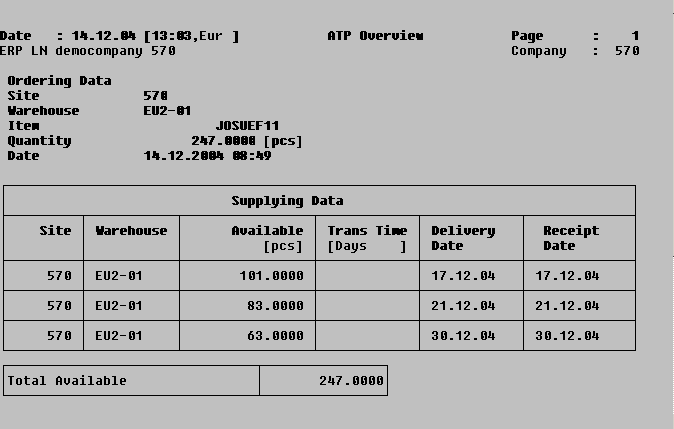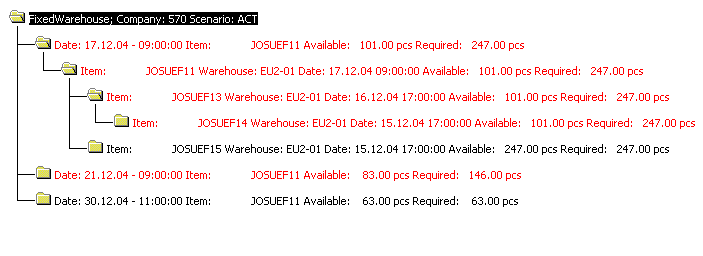Show CTP details
If you select the Show CTP Details check box in the ATP Handling (cprrp4800m000) session, a graphical browser called Capable to Promise Overview is generated, in addition to the ATP Overview report. The overview provides detailed information below each delivery line with information about the component and capacity constraints encountered during the CTP check.
This Capable to Promise overview, therefore, only provides additional information when component or capacity CTP is applied. Otherwise, both reports return the same result.
Example of capable to promise overview:
Suppose a quantity of 247 pieces of end item JOSUEF11 is required. This item has the following multilevel bill of material:
The components JOSUEF14 and JOSUEF17 are the only components in this product structure that are critical in CTP.
The other items in the bill of material all have the Component CTP check box selected in the Items - Planning (cprpd1100m000) session.
Capacity is excluded from this example.
The following is shown on the report for the fixed warehouse check :

The capable to promise overview for this fixed warehouse check is as follows:

Both reports show that the required quantity of 247 pieces can be delivered in these parts:
- 101 pieces on December 17
- 83 pieces on December 21
- 63 remaining pieces on December 30
As you see, the main lines of the report and the graphical browser are identical. However, where the ATP overview report stops at this point, the capable-to-promise overview shows which components or capacities were restrictive for delivering the entire quantity.
This overview reads as follows:
- The material for which sufficient availability was found in a branch of the product structure is marked black. The underlying branch of such a component (if present) is no longer depicted because the information is considered irrelevant for this overview. This overview concentrates on the restrictive components and capacities only.
- An example in the previous picture is item JOSUEF15, where 247 pieces can be built based on the availability of its critical component JOSUEF17. In addition, the last main line for JOSUEF11 is marked black because sufficient ATP for this item is found on December 30 to cover the remaining 63 pieces of the demand. Therefore, you will not encounter problems in terms of availability for the black lines. You can also see this by the fact that the available quantity is equal to the required quantity.
- The branch for which insufficient availability is found is marked red. The first main line is expanded for the entire branch in the example above. Because insufficient availability for JOSUEF14 was found and this is the lowest component in this branch, the entire branch is red. In addition, the second main line is marked red, but is not yet expanded.
You determine the dates as follows:
- The CTP of the end item JOSUEF11 is checked every period based on the EP parameter Component CTP bucket. If the value of this parameter is set, for example, to 1 hour, every subsequent hour, the CTP is calculated. When calculating this CTP, the lead-time offset is used to determine the required date for each component. This offset is visible in the previous picture in the branch of the first main line. JOSUEF14 is required earlier than JOSUEF13, and so on.
The available quantity is determined as follows:
- The main lines, which are end items for which the CTP is calculated, always depict the additional available quantity compared to the previous main line.
- However, the component lines always depict cumulative quantities.
- Therefore, each subsequent component line increases the available quantity compared to the previous component line.
Example
Example: If 300 pieces of JOSUEF11 are required:

The main lines for JOSUEF11 show 101 pieces available on December 20, and an additional 83 pieces on December 21.
The component lines for JOSUEF14 show 101 pieces available on December 16 (lead-time offset applied) and 184 pieces on December 17. As a result, the available quantity of 184 is a cumulated quantity of 101 + 83 pieces.
Although this method of showing the available quantity might be less transparent, this method shows extensive additional quantities for the components, rather than the cumulated quantities. From the main line, you can always see the amount of the additional quantity.